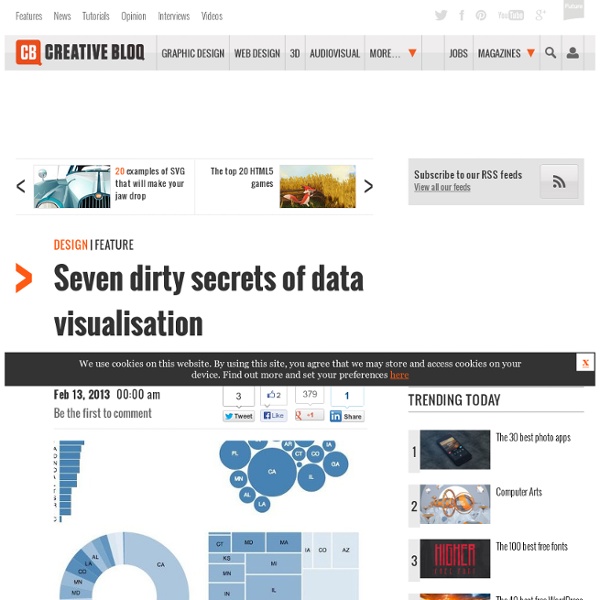Seven dirty secrets of data visualisation

Best of the visualisation web… January 2013
At the end of each month I pull together a collection of links to some of the most relevant, interesting or thought-provoking web content I’ve come across during the previous month. If you follow me on Twitter you will see many of these items shared as soon as I find them. Here’s the latest collection from January 2013. You’ll see that I’m trying out a new structure in response to recent (and, to be fair, historic and avoided!) feedback: Includes static and interactive visualisation examples, infographics and galleries/collections of relevant imagery. Creative Bits | Annual repots become infographics BitAesthetics | Paul Butler introduces a new way of looking at and visualising flight options New Scientist | Global view of warming temperatures, let’s you see how things have changed over time in a location of your choosing UX Blog | ‘People dots: Seattle area commuting’ – More magic from John Nelson. FastCo Design | ‘How A Civil War Vet Invented The American Infographic’
Reflections of a Newsosaur: Most newspaper stories are still too long
The news cognoscenti gasped when the Columbia Journalism Review recently reported that the nation’s leading newspapers aren’t writing as many long stories as they used to. But I think most stories are still way too windy. In a moment, I’ll tell you why, as briefly as I can. First the background: Tallying yarns topping 2,000 words on Factiva, CJR found the number of long-form stories at the Los Angeles Times dropped by 86% between 2003 and 2012. In the same period, stories of similar heft fell by 50% at the Washington Post, 35% at the Wall Street Journal and 25% at the New York Times. “When it comes to stories longer than 3,000 words, three papers showed even sharper declines,” said CJR. The reasons for what CJR called a “meltdown” in long-form journalism are well known: Skinnier news holes, shrinking staffs and more digital chores for slimmed-down staffs to perform – 24/7, if you please. Back in the day, words often were the only way to tell a story.
The “art” of compromise: Is there room for compromise in designing data graphics? | viewtific
In my last post, I discussed how expectations and perceptions of designers are as important to quality data visualizations as are more conventional resources, such as time, people and money. But there is also a flip side to this–there are times when, as designers, we may be faced with a choice to compromise on how we present data. The compromises we agree to–or reject–are as important to our field as anything else. (Kudos to me for resisting the urge to title this “drawing the line in infographics.”) A friend related to me a recent conversation in which an art director who, when presented with a bar graph of extreme values (very high and very low), asked the designer to “fudge” the size of the smaller bars. But, once I calmed myself down, it occurred to me that this might be something interesting to write about. Here’s what came to mind after my conversations with other designers. Let’s think about the book-binding trade of back in the day. My point? And that’s the crux of this post.
Discussion: Storytelling and success stories
I’ve not been able to keep up with all threads but it seems there have been a number of interesting discussions over the past few days covering various aspects of the role of data visualisation and what we should expect from it. Thought I’d join the party late and throw in a few thoughts of my own as I was planning on writing something about these subjects anyway. Firstly, I would recommend you take a look at Moritz Stefaner’s post about the different functions of visualisations – those that tell (or more specifically show) stories and those that don’t. I’m not going to get into deep discourse about what I believe a story is and how that relates to visualisation but I just wanted to share my view on the distinction I personally make between the two main types of visualisation function: exploratory and explanatory. Exploratory visualisations create an interface into a dataset or subject matter. Let’s look at the example of Moritz’s work on the OECD Better Life Index.
Cómo crear infografías online
Related:
Related:



